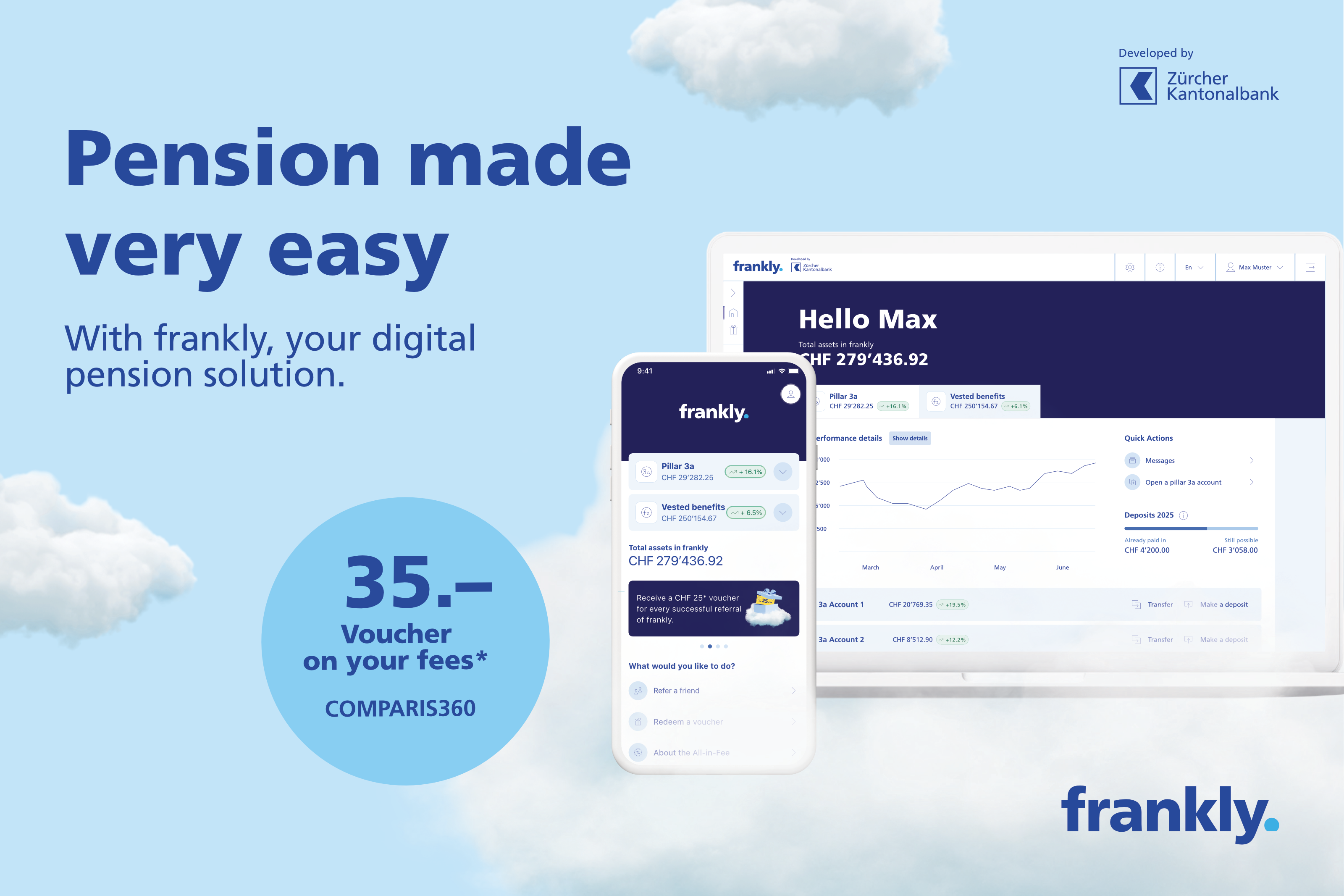Pension apps: fees for pillar 3a apps like Viac and Frankly
Fintechs are transforming private pensions. Apps like Frankly and Viac are 100% digital and inexpensive – for pillar 3a and 3b. Find out more.

03.06.2025

iStock/ferrantraite
1. What exactly do digital pension solutions offer?
You can open an account with these online pension providers instantly just by using your smartphone. The apps guide you through the process with a chatbot or a short questionnaire. This lets you know what kind of investor profile you have:
What is your risk appetite like?
Are there particular themes that you want to focus your investments on?
The app recommends a personal investment strategy based on your answers. This is particularly helpful for people who are new to finance. Depending on the provider, the portfolio risk levels accommodate investors ranging from risk-averse savers to more ambitious risk-takers.
Good to know
The recommendations vary from provider to provider. Find out about recommended investment strategies before making your first payment. You can also tailor these strategies to your needs.
2. How much do online pension solutions cost?
Fees of over 1.2% are fairly commonplace for traditional pillar 3a funds. The digital 3a products described here offer a better deal. Frankly and Finpension, for example, charge a flat fee (all-in fee). The fee depends on the strategy you choose and the amount you invest. Below is a rough overview of the fees charged by different providers.
Pension apps: comparing the costs
| Provider | Offer | Fees, including any additional costs1 | Risk levels (stock allocation in %) | Minimum investment |
|---|---|---|---|---|
| Descartes | Pillar 3a | 0.44–1.00% all-in fee incl. TER | 20%, 40%, 60%, 80% and 100% | CHF 1 |
| Vested benefits account | 0.45–0.97% all-in fee incl. TER | 20%, 40%, 60% and 80% | CHF 1 | |
| Unrestricted assets | 0.69–1.20% all-in fee incl. TER | 20%, 40%, 60%, 80% and 100% | CHF 1 | |
| Findependent | Unrestricted assets | 0.41–0.65% Up to CHF 2,000 free of charge |
20%, 40%, 60%, 80% and 98% | CHF 500 |
| Finpension | Pillar 3a | 0.39% | 0%, 20%, 40%, 60%, 80% and 100% | CHF 0 |
| Vested benefits account | 0.49% | 0%, 20%, 40%, 60%, 80% and 100% | CHF 0 | |
| Fluks 3a | Pillar 3a | 0.60% all-in fee incl. TER | 25%, 50%, 75% and 100% | CHF 2 |
| Frankly by ZKB | Pillar 3a | 0.43% all-in fee, additional fees may apply Save CHF 35 with the code COMPARIS360 until 31/12/2025. |
15%, 25%, 45%, 75% and 95% | CHF 1 |
| Vested benefits account | 0.44% all-in fee, additional fees may apply Save CHF 35 with the code COMPARIS360 until 31/12/2025. |
15%, 25%, 45%, 75% | CHF 1 | |
| Gioia 3a | Pillar 3a | 0.72–0.99% | 25%, 45%, 75% and 97.5% | CHF 1 |
| Generali | Pillar 3a | 0.76% | 25%, 50%, 75% and 100% | CHF 500 |
| Inyova | Pillar 3a | 0.80% | 20%, 40%, 60%, 80% and 100% | CHF 100 |
| Unrestricted assets | 0.90–1.20% all-in fee, additional fees may apply | 20%, 40%, 60%, 80% and 100% | CHF 2,000 | |
| Neon | Pillar 3a | 0.39%–0.45% | 25%, 45%, 65%, 80% and 100% | CHF 1 |
| Selma | Pillar 3a and unrestricted assets | 0.64–0.90% | 15%, 25%, 35%, 45%, 75% and 97% | CHF 500 |
| Tellco | Pillar 3a | 0.40–0.72% | 0%, 10%, 25%, 45% and 98% | CHF 100 |
| Vested benefits account | 0.40–0.72% | 0%, 10%, 25%, 45% and 85% | CHF 100 | |
| True Wealth | Pillar 3a | 0.13–0.21% | 0%–99%, customizable | CHF 1 |
| Unrestricted assets | 0.40–0.65% | 0%–99%, customizable | CHF 8,500 | |
| Viac | Pillar 3a | 0.00–0.44% | 0%, 5%, 20%, 40%, 60%, 80% and 99% | CHF 0 |
| Vested benefits account | 0.00–0.43% | 0%, 5%, 20%, 40%, 60%, 80% and 99% | CHF 0 | |
| Volt | Pillar 3a | 0.65–0.68% | 10%, 30%, 50%, 70% or 98% | CHF 500 |
| Unrestricted assets | 1.25–1.71% | 10%, 30%, 50%, 70% or 98% | CHF 25,000 | |
| Yapeal | Pillar 3a | 0.42–0.47% | Up to 60% | CHF 100 |
| Yuh | Pillar 3a and unrestricted assets | 0.50% all-in fee, additional fees may apply | 20%, 40%, 60%, 80% and 99% | CHF 10 |
| Zak (Cler) | Pillar 3a | 1.25% | freely selectable | CHF 100 |
1 More fees may apply for additional expenses and charges.
The ongoing costs of a fund are generally calculated as a percentage of the fund’s assets. This metric is also known as the total expense ratio (TER). The TER is useful for comparing the cost of different funds. All else equal: the lower the fee, the higher the returns.
For example:
| One-time investment in a fund | CHF 3,000 |
|---|---|
| Yearly return | 6% |
Return after 10 years
| TER 1.0% | CHF 1,887 |
|---|---|
| TER 0.5% | CHF 2,124 |
3. How safe are pillar 3a apps?
The providers assured Comparis that they comply with the highest security standards for the handling of personal data. Logging into the app is usually done with two-factor authentication. They are therefore in no way inferior to e-banking apps in terms of security. Payments are made by bank transfer.
4. When do I pay into the pension apps?
You can choose whether you want to make a deposit into your pension fund on a daily, monthly or even one-off basis. If you invest a large amount of money at once, the timing of the deposit is important.
To counteract short-term price fluctuations as much as possible, you should make regular payments. The easiest way to do this is to set up a monthly standing order. As soon as you have made the investment, you can track its progress on a daily basis in the app. The app also shows you how and where the money was invested.
5. Can I only pay pillar 3a contributions?
Pension apps allow you pay into pillar 3a. Some providers also allow you to save freely with pillar 3b funds. These include Descartes, Selma and Volt.
Pillar 3a is known as a restricted private pension. All deposits, up to a set annual maximum amount, are tax-deductible. You may withdraw pillar 3a savings five years before you reach the state retirement age at the earliest. Early withdrawals are only possible in certain exceptional cases.
Pillar 3b is an unrestricted pension. There are no maximum amounts, and withdrawal is possible at any time. However, unlike pillar 3a, 3b payments are not tax-deductible.
6. What’s the difference between a 3a account and a 3a fund?
With a pillar 3a account, you save money in a bank account. You receive annual interest on your savings. Interest rates are currently low, so a 3a account is better for building up retirement funds and saving on taxes.
A pension fund can generate much better returns. Unlike a 3a savings account, a pillar 3a fund involves investing some of your money in securities (shares, funds and bonds). Over a longer investment horizon, you are more likely to get better returns on your investment this way.
7. Summary: are pension apps worth it?
Pensions apps are cost-effective and easy to use. In addition, you can track the status of your investment in real time. An apples-to-apples comparison is virtually impossible, however, since providers have different structures and strategies.
Comparis recommends familiarizing yourself with the providers and paying particular attention to the fees and investment focus in each case. This way, you can find the solution that best fits your financial situation and outlook.
This article was first published on 21.05.2021




